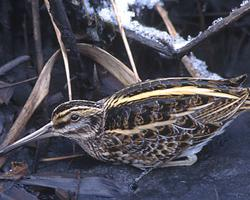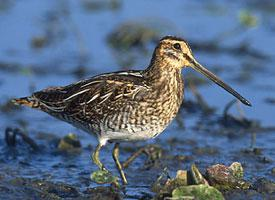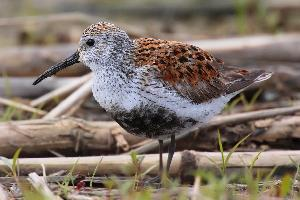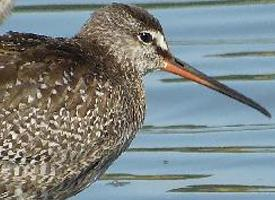
Stav ohrožení
| Neohrožen |
Popis zvířete
The Jack Snipe (Lymnocryptes minimus) is a small, elusive wading bird that inhabits the marshy terrains of Europe and northern Asia, with many migrating to southern Europe, Africa, and South Asia during the winter. This species is a member of the sandpiper family, Scolopacidae, and is particularly noted for its distinctive physical and behavioral characteristics.Measuring approximately 18 to 25 cm in length and weighing between 30 to 110 grams, the Jack Snipe is smaller than the common snipe. It possesses a short, stocky body with a comparatively short bill, which it uses to probe muddy grounds for invertebrates such as insects, earthworms, and small crustaceans. The plumage of the Jack Snipe is a complex pattern of browns, buffs, and blacks, which provides excellent camouflage against the marshy vegetation of its habitat. Its back is mottled with an intricate pattern that helps it blend seamlessly into its surroundings, while the belly remains a lighter, more uniform color.
One of the most distinctive features of the Jack Snipe is its unique bobbing behavior. Unlike other waders, it exhibits a constant, almost mechanical bobbing motion when standing, believed to mimic the movement of surrounding vegetation in the wind, thus enhancing its camouflage.
The Jack Snipe is a solitary and secretive bird, making it a challenging species for birdwatchers to spot. It is more likely to be flushed out from underfoot, flying off in a zigzag pattern before dropping back into cover, rather than being seen from a distance. Its call, a sharp, metallic "chack", is typically heard during these abrupt flights.
Breeding occurs in the spring and early summer. The Jack Snipe is not known for elaborate courtship displays; instead, it is characterized by a more subtle approach to mating. The female lays a clutch of typically four eggs in a well-hidden nest on the ground, often in a tussock of grass. Both parents are involved in the care of the chicks, which are precocial and able to leave the nest shortly after hatching but remain dependent on their parents for protection and guidance to food sources.
Conservation status of the Jack Snipe varies regionally, but it is generally considered to be of least concern due to its wide distribution and large population. However, like many wetland species, it faces threats from habitat loss and degradation, primarily due to drainage of wetlands for agriculture and urban development. Climate change also poses a long-term threat by altering the bird's migratory patterns and the availability of its wetland habitats.
In summary, the Jack Snipe is a fascinating and enigmatic bird, whose survival is intricately linked to the preservation of the wetland ecosystems it calls home. Its elusive nature and distinctive behaviors continue to captivate bird enthusiasts and researchers alike, making it a species of interest in the study of avian ecology and conservation.
Podobná zvířata
Nové fotografie zvířat
Top 10 zvířat
- Chinese water dragon (Physignathus cocincinus)
- Galápagos tortoise (Geochelone nigra complex)
- Dolphin gull (Leucophaeus scoresbii)
- Japanese macaque (Macaca fuscata)
- Colombian red howler (Alouatta seniculus)
- Sea urchins (Echinoidea)
- Diana monkey (Cercopithecus diana)
- Moustached guenon (Cercopithecus cephus)
- Common house mosquito (Culex pipiens)
- Colossal squid (Mesonychoteuthis hamiltoni)


